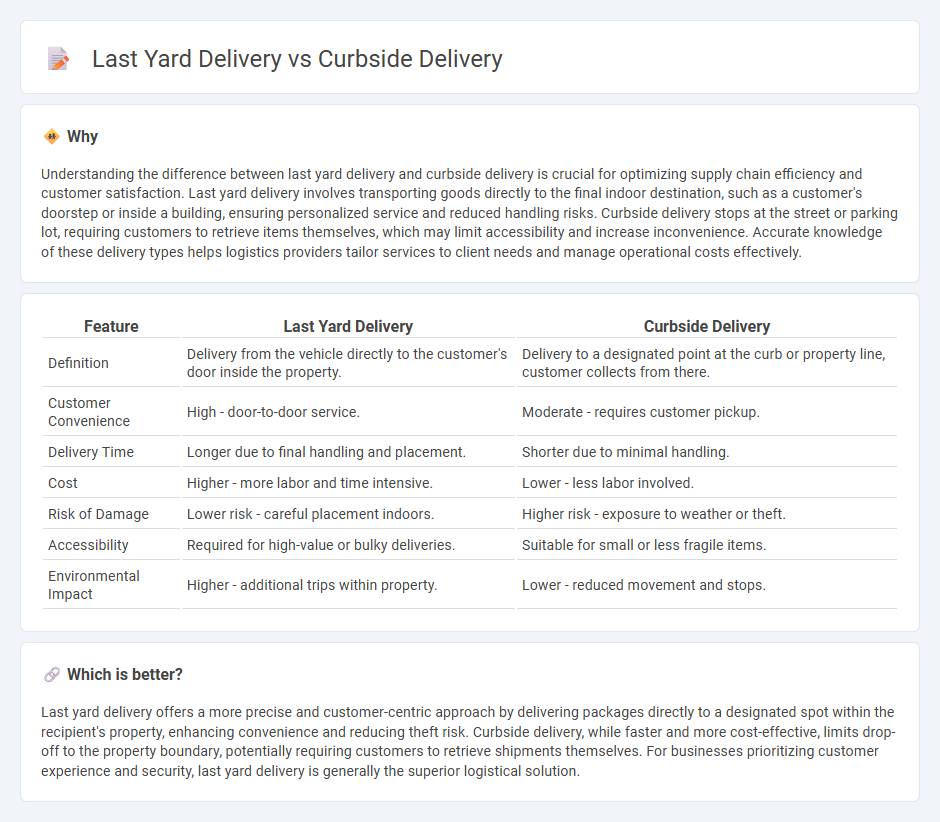
Last yard delivery focuses on transporting goods directly to the customer's designated indoor or rear-door location, ensuring personalized handling and placement, while curbside delivery leaves packages at the property's edge, facilitating faster drop-offs but requiring customer retrieval. Efficient logistics strategies evaluate factors like delivery speed, parcel size, accessibility, and customer preference to optimize last-mile operations. Explore more to understand how these delivery methods impact overall supply chain efficiency and customer satisfaction.
Why it is important
Understanding the difference between last yard delivery and curbside delivery is crucial for optimizing supply chain efficiency and customer satisfaction. Last yard delivery involves transporting goods directly to the final indoor destination, such as a customer's doorstep or inside a building, ensuring personalized service and reduced handling risks. Curbside delivery stops at the street or parking lot, requiring customers to retrieve items themselves, which may limit accessibility and increase inconvenience. Accurate knowledge of these delivery types helps logistics providers tailor services to client needs and manage operational costs effectively.
Comparison Table
| Feature | Last Yard Delivery | Curbside Delivery |
|---|---|---|
| Definition | Delivery from the vehicle directly to the customer's door inside the property. | Delivery to a designated point at the curb or property line, customer collects from there. |
| Customer Convenience | High - door-to-door service. | Moderate - requires customer pickup. |
| Delivery Time | Longer due to final handling and placement. | Shorter due to minimal handling. |
| Cost | Higher - more labor and time intensive. | Lower - less labor involved. |
| Risk of Damage | Lower risk - careful placement indoors. | Higher risk - exposure to weather or theft. |
| Accessibility | Required for high-value or bulky deliveries. | Suitable for small or less fragile items. |
| Environmental Impact | Higher - additional trips within property. | Lower - reduced movement and stops. |
Which is better?
Last yard delivery offers a more precise and customer-centric approach by delivering packages directly to a designated spot within the recipient's property, enhancing convenience and reducing theft risk. Curbside delivery, while faster and more cost-effective, limits drop-off to the property boundary, potentially requiring customers to retrieve shipments themselves. For businesses prioritizing customer experience and security, last yard delivery is generally the superior logistical solution.
Connection
Last yard delivery and curbside delivery are interconnected as integral components of urban logistics focused on the final leg of the supply chain. Last yard delivery involves transporting goods from a local distribution center to the recipient's closest accessible point, often within dense urban environments. Curbside delivery specifically targets the placement of goods at the customer's doorstep or designated curb area, optimizing efficiency and minimizing transit time in congested city settings.
Key Terms
Delivery Location
Curbside delivery involves dropping off packages at a designated point outside a customer's home or business, typically near the curb or driveway, ensuring minimal contact and quick handoff. Last yard delivery extends this service by bringing goods directly to the recipient's doorstep or inside their property, offering a more personalized and convenient experience. Explore the nuances of these delivery methods to determine the best fit for your logistical needs.
Customer Accessibility
Curbside delivery enhances customer accessibility by allowing quick, contactless pickups directly at designated locations, minimizing wait times and physical effort. Last yard delivery, however, offers superior convenience by bringing packages directly to the customer's doorstep, overcoming challenges like complex building layouts or mobility issues. Explore how these delivery models impact accessibility to choose the best fit for your business needs.
Final Placement
Curbside delivery involves dropping off packages at the customer's doorstep or property boundary, minimizing handling beyond the delivery vehicle, while last yard delivery ensures the final placement inside the customer's premises, often requiring specialized logistics and customer coordination. The final placement in last yard delivery enhances customer satisfaction by providing convenience and reducing their effort, making it essential for bulky or sensitive goods. Explore more about optimizing delivery strategies and improving customer experience in final placement logistics.
Source and External Links
Curbside delivery - Curbside delivery is a freight forwarding standard where goods are delivered simply to the curbside of the specified address without being brought inside or to the front door, mostly used for commercial deliveries.
Curbside Delivery: What It Is and How To Leverage It for Your ... - Curbside delivery today often means delivering goods while customers wait in their cars outside a storefront, with customers ordering online and selecting curbside pickup to receive their goods without entering the store.
What is curbside delivery? - Curbside delivery is a contact-minimized service where customers order online or by phone, and staff brings the order directly to the customer's car upon arrival, a method popularized by the pandemic and used by many retailers and restaurants.
 dowidth.com
dowidth.com